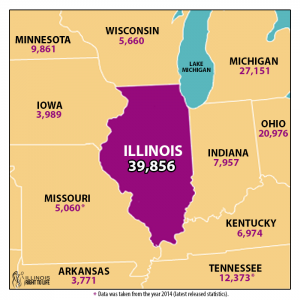
The Illinois Department of Public Health has just released the Illinois abortion statistics for 2015. In contrast to the previous 6 years, abortion numbers in Illinois reversed their steady decline and went up in 2015.
As reported, there were 39,856 abortions in 2015, up from 38,472 in 2014. This is about a 3.5% increase in abortions, with 1,384 more documented than in the previous year. Surprisingly, the increase occurred in not just the number of Illinois Residents receiving abortions (up 3.7%), but also the number of out-of-state residents coming to Illinois for abortions (up 8%).
“We are disappointed with the increased number of abortions in Illinois. At the same time, we are not surprised, given the extreme and out-of-touch policies of the General Assembly in Illinois,” said Emily Troscinski, executive director of Illinois Right to Life. “Nevertheless, we are confident that we will see a drop in abortion numbers in the coming years.”
More 2014/2015 comparisons and statistics are below:
Abortions by age group:
0-14 years old: 24.7%% decline in abortions (27 less abortions)
15-17 years old: 0.1% decline in abortions (2 less abortions)
18-19 years old: 9.8% decline in abortions (247 less abortions)
20-24 years old: 1.3% increase in abortions (140 more abortions)
25-29 years old: 11.9% increase in abortions (1,031 more abortions)
30-34 years old 5.1% increase in abortions (289 more abortions)
35-39 years old: 5.4% increase in abortions (175 more abortions)
40 -44 years old 10.5% decline in abortions (121 less abortions)
45+ years old: No increase or decline
Note: In the year 2015, 66% of all abortions happened in Chicago, IL.
So why has there been an overall increase in the number of abortions?
There are many possible reasons for last year’s bump in abortions. Here are some possibilities:
The Push for the Abortion Pill
After careful analysis of the report, we discovered an increase in the number of abortions performed between 4-7 weeks gestation, and a decline in the number of abortions performed between 8 and 15 weeks gestation. This could be explained by the growing push for the abortion pill or medical abortion, which can be given up to 10 weeks. As reported by Reuters and published in New York Magazine, medication abortions are becoming more popular in the United States. Planned Parenthood, the nation’s single largest abortion provider, has been a leader in the push, boosting their medication abortions to 43% of the abortions they perform – up from 35% in 2010.
The Illinois “Donut Hole”
At the same time, there was a large increase in the number of abortions done via dilation and evacuation, the procedure typically performed between 13 and 24 weeks after gestation. In the Midwest, Illinois is an outlier compared to its neighbor states, with more lax laws and easy access to abortion, even during the later stages of pregnancy. In an article recently published in the Business Insider, Rebecca Grant writes:
“Illinois is commonly described as a ‘donut hole’ in the Midwest… Illinois, and to a lesser extent Michigan, has become a magnet… about 3,000 abortions a year in Illinois are provided to out-of-state residents, according to the Illinois Department of Public Health . Last year, Planned Parenthood of Illinois saw a 20 percent spike in medical visits overall, with Indiana sending more patients than any other state.”
One can conclusion, among others, can be made: more women are traveling from out-of-state to receive abortions that would be restricted elsewhere. Moreover, Illinois is out of touch with the rest of the Midwest, with its lax laws and lack of protection for the unborn. No wonder Planned Parenthood has referred to Illinois as the “oasis” state. Take a look at the numbers – you’ll see what they mean:
Hence, the “donut hole” effect.
But there is a silver lining!
Yes. While analyzing the data, we came across some consistent patterns of decline in several counties in Illinois. Check it out:
DuPage – declined for the 4th straight year
Jackson – declined for the 6th straight year
Kane – declined for the 4th straight year
Kankakee – declined for the 3rd straight year
Kendall – declined for the 3rd straight year
Knox – declined for the 4th straight year
Lake – declined for the 4th straight year
McHenry – declined for the 4th straight year
Peoria – declined for the 4th straight year
Tazewell – declined for the 3rd straight year
To see the full statistical report from the IDPH, click here.

